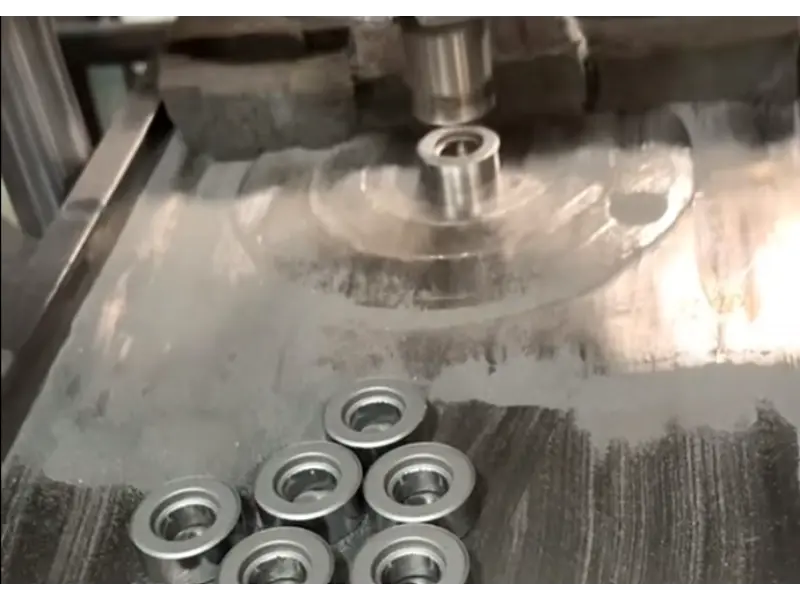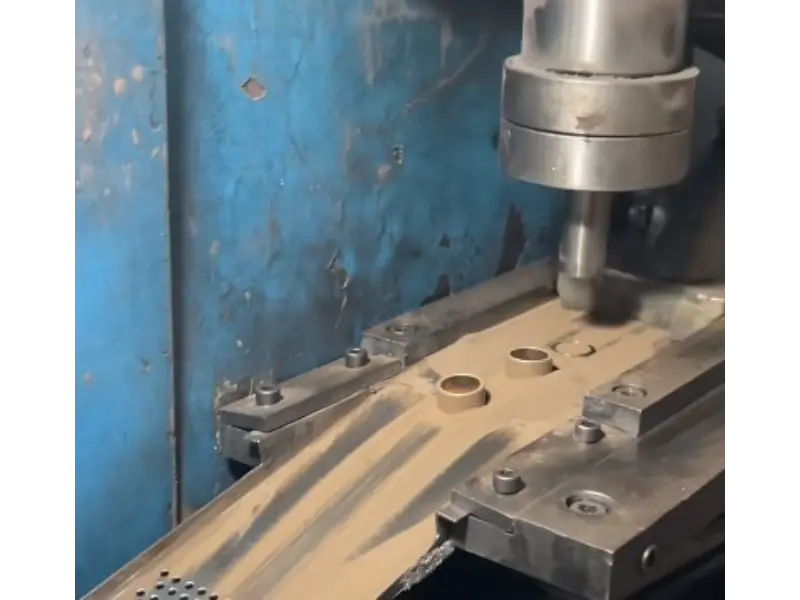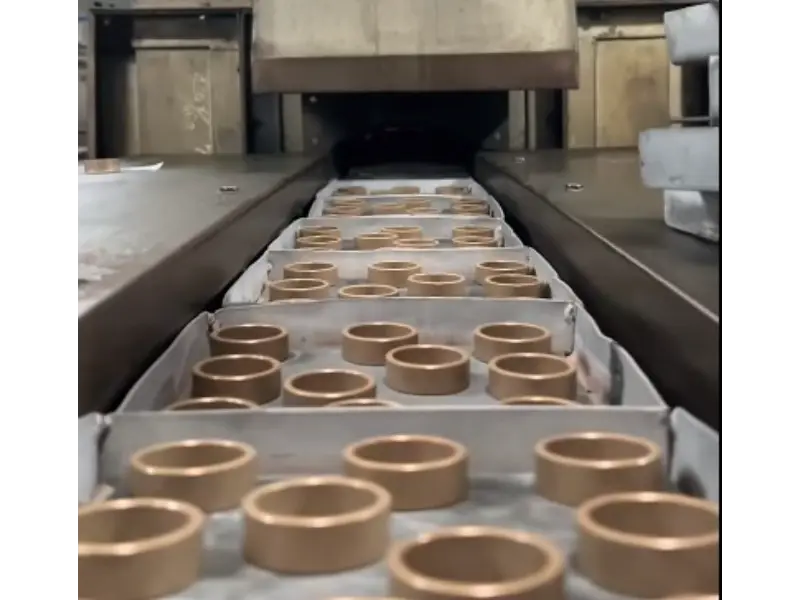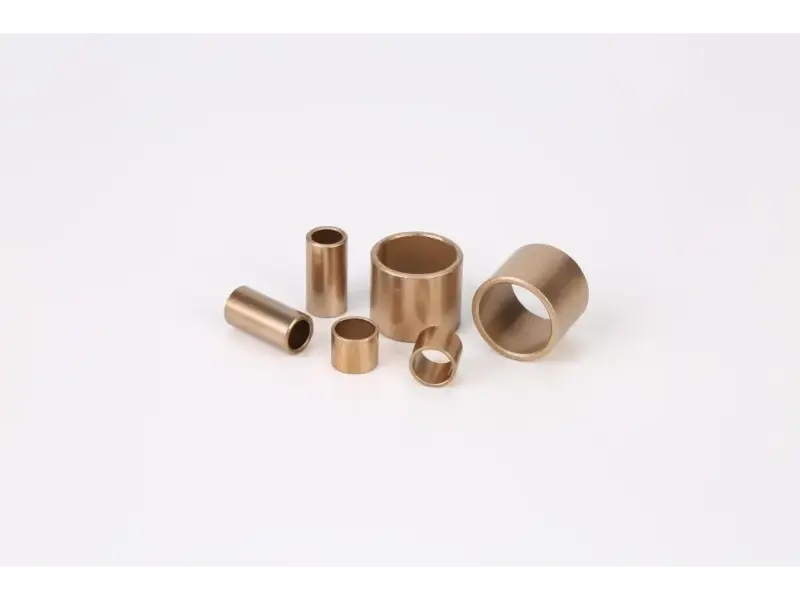High-Performance Sintered Bearings | Durable & Efficient Solutions for All Applications
In today’s demanding industrial environment, selecting the right bearing type is crucial to ensure the reliability, efficiency, and longevity of machinery and equipment. High-performance sintered bearings are among the most sought-after solutions, known for their durability, self-lubricating properties, and versatility. In this article, we’ll explore the benefits of these bearings, delve into their applications, and highlight why Welleshaft stands out as a trusted global supplier and contract manufacturer of these high-performance components.
Section 1: What is a Sintered Bearing?
High-performance sintered bearings are produced through a process known as sintering, which involves compacting metal powders under high pressure and then heating them just below their melting point. This process fuses the metal particles together, creating a porous material that retains lubricants, making these bearings self-lubricating. The most common materials.

Section 2: What are the different types of sintered bearings?
Sintered bearings come in several types, each designed for specific applications and performance requirements. Here are the main types of sintered bearings:
1. Bronze Sintered Bearings
Material: Bronze powders are used, often with additives like lead for improved lubricating properties.
Properties: Known for good wear resistance, self-lubrication, and ability to handle moderate to heavy loads.
Applications: Common in automotive parts, industrial machinery, and agricultural equipment.
2. Iron Sintered Bearings
Material: Typically made from iron powders, sometimes with graphite or other lubricants added.
Properties: Generally offers high load capacity and good machinability. May require additional lubrication in some cases.
Applications: Used in various machinery and automotive components where high strength and durability are needed.
3. Steel Sintered Bearings
Material: Made from steel powders, often with additives to enhance properties.
Properties: Provides high strength and toughness. May be used in high-load applications but often requires external lubrication.
Applications: Found in heavy-duty industrial applications and high-stress environments.
4. Self-Lubricating Sintered Bearings
Material: Typically made from bronze or other porous metals combined with lubricating additives like graphite or molybdenum disulfide.
Properties: Designed to retain lubrication within the bearing material, reducing the need for external lubrication.
Applications: Suitable for applications where maintenance is difficult or costly, such as in automotive and machinery components.
5. Composite Sintered Bearings
Material: Made from a combination of metal powders and polymer materials or other additives.
Properties: Offers a blend of metal and polymer benefits, such as improved friction characteristics and wear resistance.
Applications: Used in various industrial and consumer products, including low-speed, low-load applications.
6. High-Temperature Sintered Bearings
Material: Designed with materials that can withstand high temperatures, often using specialized metal powders.
Properties: Retains performance and structural integrity under elevated temperatures.
Applications: Ideal for applications in high-temperature environments, such as in certain aerospace or industrial processes.
7. Magnetic Sintered Bearings
Material: Composed of materials that exhibit magnetic properties.
Properties: Can be used in applications where magnetic fields are involved, offering specific magnetic characteristics.
Applications: Used in specialized applications, including some electronic devices and instruments.

Section 3: Sintered Bearings: Pros and Cons
Pros
- Low Maintenance:Sintered bearings require minimal maintenance due to their self-lubricating properties.
- Cost-Effective:The manufacturing process allows for cost-effective production of high-quality bearings.
- Durability: These bearings are designed to withstand harsh operating conditions, ensuring long service life.
- Versatility: Available in a variety of materials and configurations, sintered bearings can be used in a wide range of applications.
Cons
- Load Capacity:While sintered bearings are durable, they may not be suitable for extremely high load applications where other types of bearings might perform better.
- Precision: Sintered bearings may not offer the same level of precision as ball bearings, making them less suitable for high-speed or precision applications.
- Heat Generation:In some cases, sintered bearings may generate more heat than other types of bearings, which could affect performance in certain applications.
Section 4: What is the Difference Between Sintered and Ball Bearings?
While both sintered and ball bearings reduce friction between moving parts, they operate on different principles and serve distinct applications.
- Sintered Bearings: Manufacturers design these bearings with a porous structure that retains lubricants, providing a self-lubricating effect. They typically use sintered bearings in applications where maintenance access is limited or regular lubrication is difficult.
- Ball Bearings: Engineers use balls as rolling elements in these bearings to minimize friction. They generally select ball bearings for high-speed applications requiring precise movement, such as electric motors, bicycles, and aerospace components.
The choice between sintered and ball bearings depends on the specific requirements of the application, including load, speed, environment, and maintenance considerations.
Section 5: Sintered Materials: Properties and Applications
Sintered materials, including sintered bronze and sintered steel, are characterized by their unique properties that make them suitable for bearing applications.
1. Sintered Steel Bushing
1.1. Material Properties
- Composition:Sintered steel bushings are made from powdered steel that is compacted and sintered. The steel used is typically alloyed with other elements to enhance strength, wear resistance, and hardness.
- Strength:Sintered steel bushings offer higher tensile strength and load-bearing capacity compared to sintered bronze bushings. This makes them suitable for heavy-duty applications.
- Wear Resistance: The material is highly resistant to wear, which ensures a long service life, especially in environments with high loads and friction.
- Corrosion Resistance:While sintered steel is durable, it is more prone to corrosion than bronze. However, surface treatments like plating can improve its resistance to corrosion.
1.2. Performance
- Load Capacity: Sintered steel bushings are better suited for high-load applications due to their superior strength.
- Heat Dissipation: Steel generally has lower thermal conductivity than bronze, which means sintered steel bushings may not dissipate heat as effectively.
- Self-Lubrication: While sintered steel bushings can retain lubricants within their porous structure, they may require additional lubrication in some applications, especially under extreme conditions.
1.3. Applications
- Heavy-Duty Machinery:Ideal for applications where high strength and load-bearing capacity are essential, such as in construction equipment, industrial machinery, and automotive components.
- Shock Loads:Sintered steel bushings perform well in applications with frequent shock loads or vibrations.
2. Sintered Bronze Bush
2.1. Material Properties
- Composition:Sintered bronze bushings are made from powdered bronze, typically an alloy of copper and tin, that is compacted and sintered.
- Porosity:The porous nature of sintered bronze allows it to retain lubricants, providing excellent self-lubricating properties.
- Wear Resistance: Bronze offers good wear resistance, though it may be slightly lower than that of sintered steel.
- Corrosion Resistance:Sintered bronze is highly resistant to corrosion, making it suitable for use in harsh environments, including those with exposure to moisture and chemicals.
2.2. Performance
- Load Capacity:Sintered bronze bushings have a lower load-bearing capacity than sintered steel, making them better suited for moderate-load applications.
- Heat Dissipation:Bronze has excellent thermal conductivity, which allows sintered bronze bushings to dissipate heat more effectively, reducing the risk of overheating.
- Self-Lubrication:The primary advantage of sintered bronze bushings is their ability to self-lubricate, making them ideal for applications where maintenance is challenging or where continuous lubrication is necessary.
2.3. Applications
- Low to Moderate Load Applications:Commonly used in applications with moderate loads and speeds, such as electric motors, household appliances, and office equipment.
- Corrosive Environments:Due to its excellent corrosion resistance, sintered bronze is ideal for applications exposed to moisture, chemicals, or other corrosive elements.
- Quiet Operation: Sintered bronze bushings operate quietly, making them suitable for applications where noise reduction is important.
3. Sintered Steel Bushing vs. Sintered Bronze Bush: Which to Choose?
The choice between sintered steel and sintered bronze bushings depends on the specific requirements of the application:
- Choose Sintered Steel Bushing: If your application involves high loads, frequent shock loads, or requires maximum strength and durability, sintered steel bushings are the better choice. They are well-suited for heavy-duty industrial and automotive applications where strength is paramount.
- Choose Sintered Bronze Bush:If your application involves moderate loads, requires self-lubricating properties, or is exposed to corrosive environments, sintered bronze bushings are the ideal choice. They are perfect for situations where quiet operation and low maintenance are key considerations, such as in home appliances or electric motors.

Section 6: Why Choose Welleshaft for Sintered Bearings?
Welleshaft is a leading global supplier and contract manufacturer of sintered bearings, offering a wide range of products to meet the needs of various industries. With over 13 years of experience in the field, Welleshaft has earned a reputation for delivering high-quality, reliable, and cost-effective solutions.
What Sets Welleshaft Apart?
- Quality Assurance:Welleshaft adheres to strict quality control standards, ensuring that every bearing produced meets the highest levels of performance and durability.
- Customization:Welleshaft offers customized solutions to meet the specific needs of each client, providing tailored products that deliver optimal performance in any application.
- Global Reach: Welleshaft serves clients worldwide, delivering sintered bearings quickly and reliably through its strong global network.
- Expertise: Welleshaft’s team of experts provides exceptional customer service by offering technical support and guidance to help clients select the right bearings for their specific needs.
Section 7: Frequently Asked Questions
-
How do sintered bearings differ from other types of bearings?
Sintered bearings feature a unique porous structure that retains lubrication internally. Unlike ball or roller bearings, which typically need external lubrication and have different designs and performance characteristics, sintered bearings provide self-lubrication through their material. -
Are sintered bearings suitable for high-speed applications?
Sintered bearings generally perform best at moderate speeds and under high loads. They do not handle very high speeds as effectively as ball bearings or other high-speed bearing types. -
How do you maintain sintered bearings?
Users maintain sintered bearings easily due to their self-lubricating nature. However, they should operate the bearings within design limits and regularly inspect them for signs of wear or damage. -
Can sintered bearings be used in high-temperature applications?
Yes, manufacturers design some sintered bearings specifically for high-temperature environments by using materials that maintain performance under elevated temperatures. -
How are sintered bearings manufactured?
Producers create sintered bearings through powder metallurgy by compacting metal powders into molds and heating them to fuse the particles, forming solid yet porous components. -
What factors should you consider when choosing a sintered bearing?
You should consider load capacity, operating speed, temperature range, lubrication needs, and specific application requirements to select the right sintered bearing. -
Are sintered bearings environmentally friendly?
Sintered bearings contribute to environmental friendliness by reducing the need for additional lubricants due to their self-lubricating properties. Additionally, the powder metallurgy manufacturing process minimizes waste compared to machining solid metal parts.
Conclusion
Sintered bearings are an excellent choice for applications requiring durability, low maintenance, and reliable performance. Whether you need sintered bronze bearings for automotive applications, sintered steel bushings for heavy-duty machinery, or custom sintered bearings for specialized uses, Welleshaft is the trusted global supplier and contract manufacturer you can rely on. With a commitment to quality, customization, and customer satisfaction, Welleshaft delivers the high-performance solutions your business needs to succeed.


Great article! I really appreciate the clear and detailed insights you’ve provided on this topic. It’s always refreshing to read content that breaks things down so well, making it easy for readers to grasp even complex ideas. I also found the practical tips you’ve shared to be very helpful. Looking forward to more informative posts like this! Keep up the good work! YouTube Downloader Online
Great article! I really appreciate the clear and detailed insights you’ve provided on this topic. It’s always refreshing to read content that breaks things down so well, making it easy for readers to grasp even complex ideas. I also found the practical tips you’ve shared to be very helpful. Looking forward to more informative posts like this! Keep up the good work!